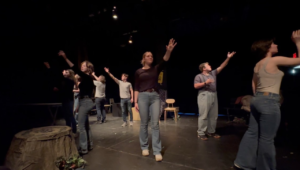What We Ought Not Forget: Chinese Laborers and the Transcontinental Railroad

Map display of the Transcontinental Railroad. Courtesy of americanhistory.si.edu
By William Corrigan
Forgotten Workers: Chinese Migrants and the Building of the Transcontinental Railroad, is a relatively new exhibit on the first floor of the Nation Museum American History, located in their American Enterprise section. From its opening on May 10, the new section has both commemorated the 150th anniversary of the conclusion of the Transcontinental Railroad’s construction, and effectively called into question its legacy in American culture as a landmark achievement in trade, transport, and the triumphs of technology in the Industrial Age.
The display begins with a floor map of the United States in the style of the time, showing the path of the railroad cutting across from the beginnings of the Great Plains in Nebraska, through the towering Sierra Nevada Mountains in the heart of the Rockies, to the shores of San Francisco. The map serves as a reminder of both the scale of the undertaking, and as a reminder to all who are used to modern highways and air travel that traveling from “sea to shining sea” used to be much more difficult.
Then the focus narrows in, from the grandeur of the railroad at large, to the story at hand: the exploitation of Chinese immigrant workers, primarily by the Central Pacific Railroad company in its construction of rail from California to the center of what is now Utah. The story is told just as much in photographs and artifacts as it is through documents and the stories of those who endured such treatment.
Workers worked six days a week, from dawn to dusk, and received no modern benefits. Night crews were a common tactic to speed construction and reward workers with extra wages, but were especially dangerous given the limits of lighting technology. For Chinese workers, these effects were compounded while white workers were provided with meals and train cars to live in by the railroad company, Chinese workers were expected to provide their own food, and lived in tents. They were paid substantially less, given jobs no one else would do, and were often persecuted by Americans for their simple presence in the nation.
This hostility extended to all aspects of life, as segregation in law, practice, and violence against Chinese workers and their families. The vitriol of Americans toward them was so great that even their meager contracts with the railroad companies were negotiated by Chinese firms or contractors on their behalf, such as the Chinese Six Companies in San Francisco, rather than having the opportunity to be employed on their own terms.
Almost ninety percent of the work done on the Pacific portion of the Transcontinental Railroad was undertaken by Chinese workers, with ten to fifteen thousand workers emigrated to the United States. Hundreds died in accidents from manual labor, blasting powder explosions, and diseases. They toiled at the most dangerous aspects of a great industrial project, for insufficient pay, and suffered despicable treatment for their efforts. Their torment should give us pause when we laud the accomplishments of Industrial America, and cause to question its legacy.
Forgotten Workers: Chinese Migrants and the Transcontinental Railroad will be open until Spring 2020. The Nation Museum of American History is open from 10 AM to 5:30 PM daily, and is accessible from the Metro Center or Smithsonian Metro stops. The address is 1300 Constitution Ave NW. For any student interested in history, labor politics, race relations, or feats of industry, this is a must see exhibit!







